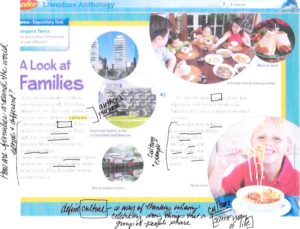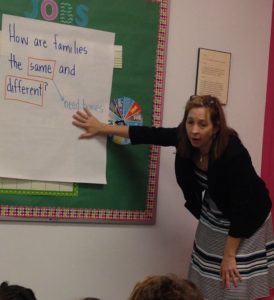
As we ask transitional level readers to engage in close reading, let’s be aware of tricky details. Below I share my analysis of one informational text that is very similar to other texts we use in our classrooms.
A few weeks ago, I taught several second grade “close reading” lessons with informational texts from the Wonders program. Wonders interpretation of “close reading” is a little too broad for me–the texts they provide are too long and the time they suggest is too quick. Instead of focusing on one question, the teacher’s guide has several questions (focused on a myriad of skills) for students that basically assess understanding versus teaching students how to read to comprehend.
That said – there is an essential question for each unit in the system and each week. That’s a good thing. For the lessons I taught, I focused on reading the text closely with students to answer the essential question. For an informational article entitled “A Look at Families,” I led a whole group lesson (20-25 minutes on the carpet – text projected by document camera, all students had a clipboard, pencil and copy of the text) and we worked on the first four paragraphs. That was it! AND that was enough! Ideally, you might do a second lesson gradually releasing responsibility further or, with students at a transitional reading level, take the text back to guided reading and complete in small groups. There were students reading below grade level – but with the type of scaffolding I offer, they were able to access this text; definitely using instructional level texts with these students during small group time. (Pre-A and emergent readers do not need to work on close reading!) For more information on the logistics of a lesson like this, see a previous blog entry – “I can’t live without doing” during close reading lessons.
To the text – the essential question was “How are families the same and different?” Now, really, this is two questions. For some of our students, this would be too much of a cognitive load and I might modify the question at first to “How are families the same?”

The strength of many of the informational (non-narrative) texts in the Wonders system is that there are clear topic sentences. So in this text, the following four sentences stand out and lead into a description of a particular aspect of family life in different cultures –
- All families need homes.
- All families share food.
- All families talk to each other.
- All families celebrate together.
So if you’re working with students on identifying the main topic of a multi-paragraph text and the focus of specific paragraphs in the text (RI 2.2), this text lends itself to that.
The tricky part comes with the types of details that follow. Check out the following excerpt:
All families need homes. Some families live in large cities. They might live in tall apartment buildings. Many families live in the same building.
Some families live near water. Some families live in houses on stilts. Stilts are tall poles. They keep the homes safe from the water.
Okay. Seriously? A 2nd grader has to do A LOT of work here. How do these details support the topic sentence “All families need homes”? The details are actually more about “Families live in different types of homes.” That said, we can still glean some information about how families are the same and different.
If we think about the essential question, “How are families the same and different?” then we have to infer that if some families live in large cities and some families do not – or they live in small cities. So the child has to make some inferences when he or she thinks through how these details are answering the essential question – while also just making sense of what he or she is learning. (Stilts? Really?) We need to be aware of this kind of detail and coach for this kind of thinking.
I’m not saying cast this text aside. For many, these texts are the primary source of text in the classroom. I also think that students need to grapple with texts that are tricky.
One phrase I would definitely teach students while close reading a text like this is “the author is sharing examples.” After each of the next three topic sentences in the text, the author gives examples of the topic. (Better than after the first.) So after the topic sentence about all families celebrating together, the author gives the example of the Indian holiday Diwali and the U.S. holiday Independence Day. Second grade students can handle the concept of “examples.”
One of the benefits of a unit of study that has essential questions is that students do not have master the content in every article they read. I wouldn’t ask students to completely understand the concept of “stilts” or “Diwali.” Over the course of several lessons, their understanding of content will deepen and their ability to articulate how families are the same and different should increase.
My biggest caution then is to beware of the types of details authors use after the topic sentences. They may not even answer the question or they may require inferring or they may just be tricky to fathom. The solution is not to find another text – but to do your own close reading of that text and be aware of the hurdles students will have to jump to comprehend the text. You’ll notice in the image above – I studied and took notes before teaching. I can’t live without doing this. I’m a stronger reader for it – and after doing this many times, it’s become much easier to think about these texts for and with kids.
Hope this helps.
Sunday
